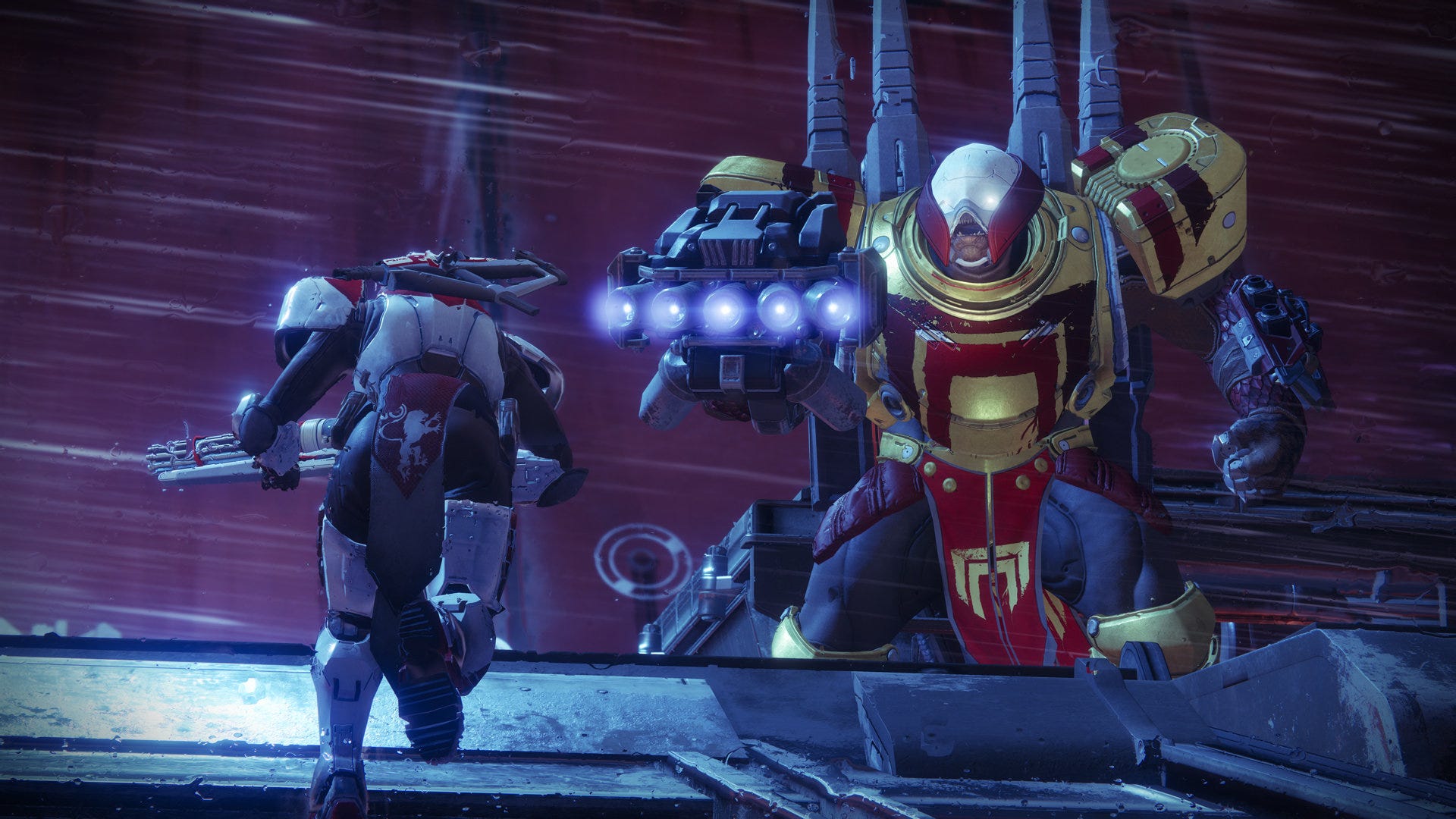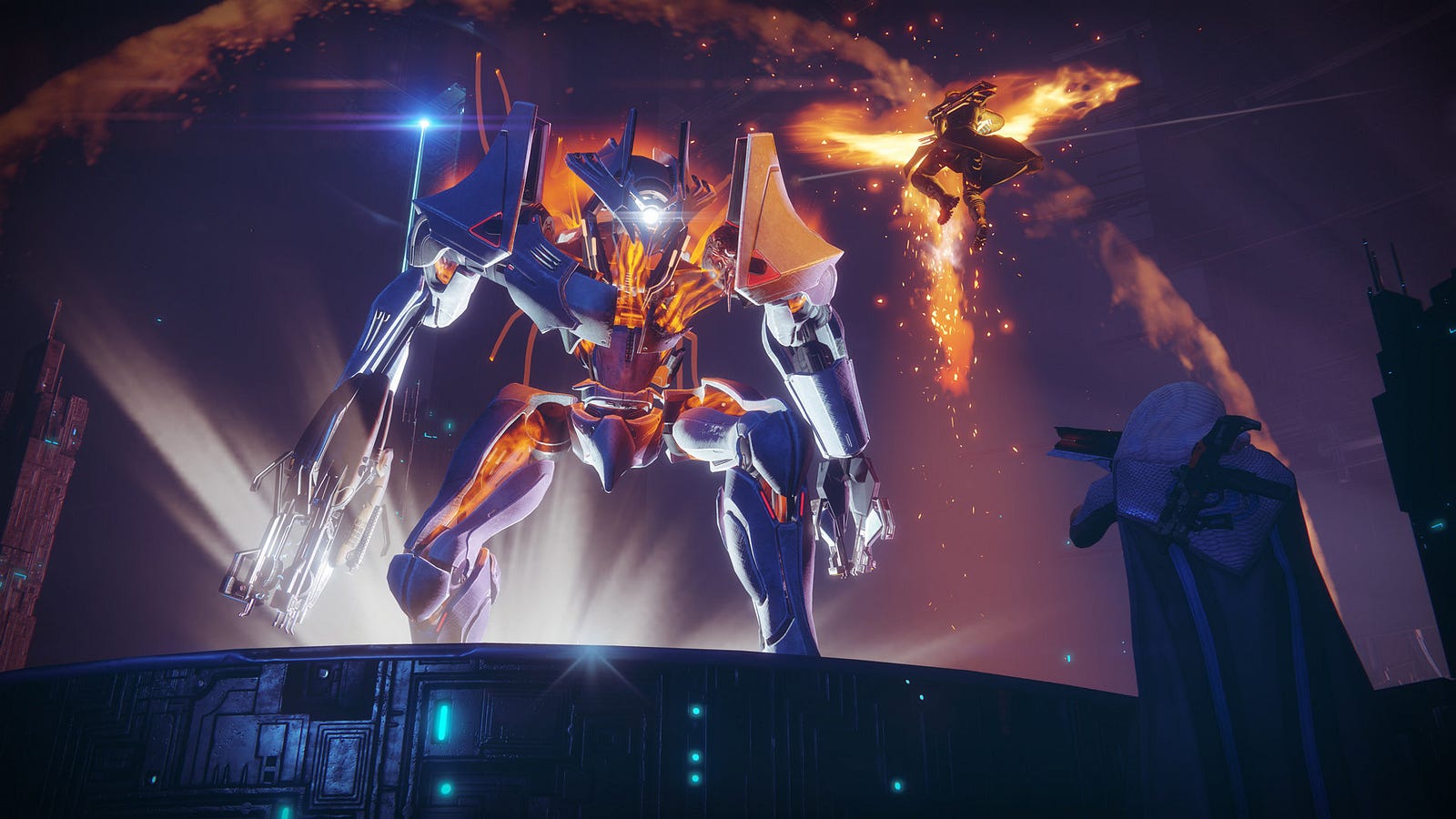Destiny 2 -- What might have been
Destiny 2 promised to deliver a compelling day one experience, built on the success of the first title. On release, though, players said 'great gameplay, not enough content'. What happened? What might have been?

Disclaimer: This analysis is based entirely on my personal opinions. I have several friends who are currently or formerly at Bungie and I have a tremendous amount of respect for them and the studio as a whole. This piece is based entirely on outside observations, I have no insight into the internal operations of the studio. Any guesses made at the thought processes informing decisions is entirely conjecture on my part and based only on public information.

“How much longer are we supposed to stand here, my leg is falling asleep. Wait, are you taking a video!??”
When Destiny released on September 9, 2014, it dominated industry buzz and water cooler discussions for weeks. The promise of an MMO shooter created with Bungie pedigree was exciting. Bungie had bought themselves back from Microsoft, were releasing a new IP, and the the community was at peak hype.
As feedback rolled in, it largely centered around two points. First was that the moment-to-moment gameplay had exactly the level of polish and tightness that players wanted and expected. Second, there wasn’t enough content. This second point caused concern for some, but not for me. Making a service based game that lasts for years must be done incrementally. The crucial first step is to create compelling core gameplay, next the progression and end-game systems must be refined, and finally the floodgates of content can be opened, built on top of the strong foundation that’s been established. This is what I hoped would happen, and basically it happened just that way. The result, years after release, was a compelling looter shooter / MMO with Bungie polish, substantial endgame systems, and a dedicated player base.
When Destiny 2 was announced, I thought to myself “Sweet, Destiny is coming out of beta”. In effect the first Destiny was a beta, and over several years of development following its initial release, it had been refined and polished into a compelling experience. The natural next step therefore was to create brand new content on top of the already mature systems and to invite all of the players that didn’t have the patience or endurance to stick with the first game through it’s multi-year process of self discovery.

“Sure, Thanos’ gauntlet has more colors, but it lacks the cohesion and simplicity of my rocket fist”
—Red boss
The strategy for Destiny 2 therefore was simple. Strong new story, environments, upgraded visuals, and importantly, content. Content, content, content. Delivering multiple years worth of content on day one with Destiny 1 had been impossible. After putting in their time on the first title, Bungie was now set up to reap what they had sowed. Destiny 2 was supposed to be the 1.0 release of Destiny and it was going to be awesome.
Then it released. The feedback? Great core gameplay, and not enough content. Bungie WHY?!? Destiny 2 released with brand new systems-- they had thrown away everything they had built and started over again. Somehow Bungie misunderstood their play and had thrown away their single most valuable asset-- all of the insight, refinement, optimization, improvement, and polish that had made Destiny 1 what it eventually became, an excellent lifestyle game.
“Hold on a second”, you might be thinking. “You can’t have expected Bungie to have shipped a polished, content-rich version of the first game and called it Destiny 2, can you?”
Yes, reader, yes I can.
Okay, maybe it wouldn’t have worked to ship with the exact same systems. StarCraft 2 delivered a more polished version of the original and ultimately it flopped. However it doesn’t need to be an either/or approach. Destiny 2 had the chance to ship with strong endgame systems on day one, which would have allowed Bungie to focus on shipping a lot more content out of the gate. This foundation would then have provided ample opportunity to experiment with new features and systems to make the game feel fresh, without risking all of the challenges they spent years working to solve with Destiny 1.
As an example, DLC boundaries provide great opportunities to experiment with new, additive systems. Imagine a rarity class that is unique to each DLC season, providing a natural place to try out new ways to farm, upgrade, and optimize progression. If an experiment pays off, it can be integrated into the core system-- if not, it can be thrown away in favor of the next experiment. Importantly, this approach means that there is no risk that players show up on day one and discover that there’s not enough for them to do.
While it’s hard to say why Bungie decided to start from scratch on their progression and end game systems, I will make wild conjectures that might be relevant. Not only is it fun to make stuff up, but I’ll also make a recommendation or two about how a studio might try to protect itself from these theoretical missteps.
Note: these examples are oriented around large studios, though I imagine the principles could be applied to small shops as well. Though everything is always easier in a smaller organization!

“Lightsaber flame swords, arcs of orange dust, and lots of orange particles to highlight the big, orange boss” -- New creative lead sharing bright, new, orange, ideas
Scenario 1. Now it’s my turn
“Now it’s my turn!!!”
— new creative lead shouting triumphantly and pumping their fist in the air victoriously
It’s possible that someone had finally been given their chance to call the shots. Everyone wants a chance to call the shots! Relying upon the successes of your predecessors is no fun, and it’s certainly no way to make a name for yourself. Whether well intentioned or not, many creatives are susceptible to throwing away years of institutional knowledge for no other reason that they want to try their hand at creating something great without being bogged down by earlier ideas. This is one of the most damaging, silent enemies of long term success for creative studios because thousands of person-years of creative knowledge are being lost, but it doesn’t show up as a line item in the budget.
Solution:
Create a Domain Expert Advisor team (DEA sounds pretty cool). Typically, a team will create a design proposal and seek approval from stakeholders. Stakeholders represent the organizational leadership who sign off on the plan. Missing from this loop is input from domain experts within the organization (when did leadership last do meaningful creative work?).
The advisor team does not have a decision making role in the process, but they serve two important functions. First, they will provide an overview of insights, lessons learned, and takeaways to the new team before the new team starts designing and planning. Second, the DEA hears the proposal at the same time as the leadership team and provide comments and feedback to both the team and the stakeholders. It is essential that the stakeholders hear feedback directly from the DEA to avoid the over-eager new lead from dismissing the feedback simply because they want to. Beyond that, the DEA participates in stakeholder reviews to help identify problems early, and are available on an as-needed basis.
Scenario 2. The old stuff is no good
“That stuff didn’t work. This time we need bigger bosses, bigger weapons, bigger environments, bigger buildings. And most importantly, more orange… stuff”
— ambitious producer advocating for fresh, bold, new ideas (these ideas will be championed and led by said producer, of course).
Response:
When a studio spends years iterating on content and systems, inevitably many players will be lost along the way. Maybe they bounced out early when they ran out of content, or maybe they moved on to newer, shinier things (rubiks cube speed solving competitions for example). Therefore it can be difficult to look at the final result and answer the question of whether that result would have retained any of the players who churned along the way.
Given that we only get one shot at this (I don’t share my time machine with anyone), we must make the best decisions with the information we have. The important question to answer regarding the final state of Destiny 1 is whether it was maintained a dedicated player base (it did). This means you can say with absolute certainty that some players find this experience to be deeply compelling. To walk away from those systems in favor of bold new ideas, you have forfeited this certainty. There is absolutely no way to tell if the new ideas will be equally as compelling. If experience is a teacher (it is), and if it took years to polish those systems last time (it did), then you should expect it will take years to polish the new systems into something similarly deep and compelling (it will).
Solution:
Preserve the known good and treat it as the core experience. Design a meta system that gives the team the chance to experiment with new, supplemental systems. If these new systems prove to be winners, incorporate them into the core. If not, scrap them and move on. Just make sure to preserve that core experience so you know players have something strong to sustain them through the new innovations and experiments. Not only is this safer, it also allows the studio to spend many more resources on day-one content (crazy thought-- maybe resources could even be spent tutorializing the endgame systems and improving the UX / UI to onboard players into the endgame).
Scenario 3. The Visionary
“Yeah, yeah, but just imagine if….”
—someone excitable describing the next Battle Royale AR MMO powered by AI on the blockchain.
Response:
Some people just like to make stuff up. Honestly, who doesn’t, it’s fun! Some people can paint castles in the sky with their words while simultaneously curing cancer and rescuing puppies in their minds. It turns out that making up grandiose ideas is easy. It’s approximately 10,000 times easier than executing on an idea. How does an organization immunize itself from snake oil salesmen and charlatans? How does an organization make moonshot bets that leverage a visionary idea while giving themselves a chance of actually pulling it off? Glad you asked.
Solution:
The DEA team described above will go a long way to help catch the fakes, because trusted individuals within the organization will be able to call bullshit early on in the process. However some visionaries are not fakes, they are just people with big ideas who are not equipped to bring that vision to life (not sure how valuable these people are, but let’s run with it). In this case the organization must first recognize that the visionary is not an operator, and second, they must require that an execution partner be identified before the plan is created and approved. If the visionary is responsible for the plan, the whole thing is doomed before it began (remember this visionary doesn’t have the skills to execute, which means they definitely don’t have the skills to develop a viable plan). Accountability can be tricky here-- it’s probably safest to treat the partnership as mutually accountable because it’s too hard to tell if failure was caused by execution lead or because the visionary stubbornly stick to their batshit crazy ideas regardless of constraints or what the team learns along the way.

"Forget the Iron Fist, they call me… the Iron Gun"
I will wrap up by saying that I’m a tremendous fan of Bungie and am hopeful for their success over the long haul. I love the franchise and the level of polish and care they deliver every time. I hope that they continue to improve Destiny 2 and create compelling experiences that draw players into the ecosystem as and keep them for the long haul. Lastly, I hope that this piece has been helpful at least to spark thoughtful discussion (I’ll leave the thoughtful part to the rest of you).
The original version of this article was published here on Medium.
Read more about:
BlogsAbout the Author(s)
You May Also Like







.jpeg?width=700&auto=webp&quality=80&disable=upscale)








